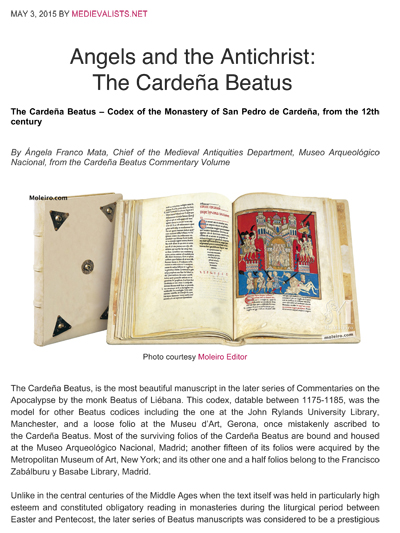Angels and the Antichrist: The Cardeña Beatus
The Cardeña Beatus – Codex of the Monastery of San Pedro de Cardeña, from the 12th century
By Ángela Franco Mata, Chief of the Medieval Antiquities Department, Museo Arqueológico Nacional, from the Cardeña Beatus Commentary Volume
The Cardeña Beatus, is the most beautiful manuscript in the later series of Commentaries on the Apocalypse by the monk Beatus of Liébana. This codex, datable between 1175-1185, was the model for other Beatus codices including the one at the John Rylands University Library, Manchester, and a loose folio at the Museu d’Art, Gerona, once mistakenly ascribed to the Cardeña Beatus. Most of the surviving folios of the Cardeña Beatus are bound and housed at the Museo Arqueológico Nacional, Madrid; another fifteen of its folios were acquired by the Metropolitan Museum of Art, New York; and its other one and a half folios belong to the Francisco Zabálburu y Basabe Library, Madrid.
Unlike in the central centuries of the Middle Ages when the text itself was held in particularly high esteem and constituted obligatory reading in monasteries during the liturgical period between Easter and Pentecost, the later series of Beatus manuscripts was considered to be a prestigious item by the newly founded monasteries. The lavish colouring based on reds, blues and greens combined with gold leaf on haloes and architectural details all highlight the magnificent decoration in complete harmony with the text transcribed by skilful copyists who may, like St Martin of León, have complained about the terrible back and shoulder pains caused by such hard and constant work. The illumination carried out in c. 1175-85 is clearly influenced by insular art and vaguely reminiscent of Carolingian art. This ostentatious decoration is one reason why this manuscript has survived in quite good condition.
f. 42r, The message to the Church of Ephesus
The illustrator employs a composition consisting of John and the angel to the left. John is holding the book and the angel stretches out his right hand towards him as if in conversation. The Church of Ephesus stands on the right on two levels: above, three arches and below, a horseshoe arch inside which an altar can be seen. It is topped by four towers, the two centre towers being more elegant and well-finished. The wealth of red- and gold-based colours contrasts with the poor skill of the miniaturist. The Manchester illustration has similar iconographic characteristics.
f. 10A, The angel with the fifth trumpet
The explanation of the different elements that comprise the storia is as follows: the bottomless pit is the human heart deep inside which Satan takes refuge. The smoke arising from it represents the sins committed in the world that hide the Church’s preaching. The locusts mix with the smoke and are compared in the Apocalypse with scorpions. They are depicted as lizards, becoming frogs in the San Pedro de Cardeña and the Rylands Beatus (f. 130r), with bodies striped like zebras in the former and spotted in the latter.
The Cardeña illustration is inspired by the Gerona Beatus (f. 154v) in which, unlike Magius’ Beatus and that of Valcavado, the mention ABISSUS has been eliminated. The square structure of the illustration under study is divided into three wide bands of different colours: a blue sky sprinkled with golden stars, brown and green. The green strip at the bottom contains the abyss in the form of a hollow inside which sits a figure holding a key next to a star. The figure is not winged, unlike the Lorvao codex, as if it were the angel himself sounding the trumpet. The human figures tormented by locusts that have already emerged from the bottomless pit have different, very agitated postures and are clothed in accordance with the text. Some are barefoot whilst others wear shoes. They are not naked because they are not dead. The column of smoke mingles with flames. The great star falling from the sky is golden. The Arroyo Beatus (f. 96v) features completely different conventions, evidence that it was inspired by a different source.
f. 13B, Tables of the Antichrist
The first folio shows, inside a thick, green frame with hand-drawn, black lines, the table of the Antichrist with the cross of Christ in the central box. The Antichrist is like Christ but the complete opposite. The gold cross is Greek and reminiscent of the Oviedo cross in the codices of earlier centuries. The inscriptions in capital letters along each side allude to the eight names to be entered in the following table. “Octo nominibus nuncupabitur in septem regna que est bestia cum septem capita et decem cornua serpens”.
The names of the Antichrist also appear in different orders although they are usually set inside the corresponding horseshoe arches, as is the case of the San Pedro de Cardeña Beatus, following the arrangement in the Gerona codex. The arches are small, therefore to make the script clearer, the names are written in double lines with the second part on a level with the capital. The Osma Beatus breaks this rule by placing the names vertically from top to bottom.
